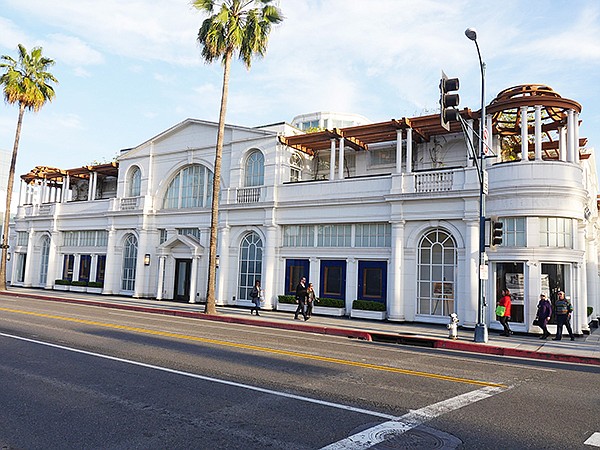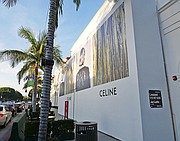RODEO REAL ESTATE SELLS
Former Brooks Brothers Building on Rodeo Drive Sells for $245 Million
Rodeo Drive continues to rank as the most expensive commercial real estate in Los Angeles County.
That was reinforced with the recent sale of the former Brooks Brothers flagship at 468 N. Rodeo Drive in Beverly Hills, which went for $245 million. Brooks Brothers opened a new flagship in November at the recently remodeled Beverly Center.
The original asking price for the former Brooks Brothers site was $300 million. The structure was up for sale by the trust of the family of Margaret J. Anderson, who built the pink stucco Beverly Hills Hotel in 1912.
Even though no public announcement of the sale was made, documents show that a group named 468 N. Rodeo Drive LLC acquired the 22,251-square-foot two-story building in September for a price that came out to $11,010 per square foot. According to sources, luxury conglomerate LVMH, which declined to comment on the deal, is reportedly behind the transaction.
Jay Luchs, vice chairman of Newmark Knight Frank, handled the listing but declined to comment about the transaction.
LVMH, or Moët Hennessey Louis Vuitton, already has a strong presence on Rodeo Drive. It owns or leases more than eight buildings on the three-block luxury-retail street. A majority of its fashion brands, including Louis Vuitton, Dior, Celine, Givenchy, Fendi and Rimowa, have flagships on the street.
The purchase of the building might be the latest LVMH move to increase its holdings on the street, which has been a center for high-end shopping for more than 40 years.
On March 28, it was announced that LVMH spent $110 million on a 6,200-square-foot building at 456 N. Rodeo Drive. A construction barricade bearing the name Celine currently covers the exterior of the property.
In August 2016, LVMH paid $122 million for the House of Bijan building at 420 N. Rodeo Drive, a purchase considered to be one of the most expensive on the street. That purchase price came out to $19,405 per square foot, which beat out Chanel’s 2015 purchase of a Rodeo Drive store for $13,217 per square foot.
While the sale of 468 N. Rodeo Drive did not break any records, Andrew Turf, senior vice president of high-street retail services at CBRE, said the former Brooks Brothers building sale was substantial in an area where store leases cost about $50 to $75 per square foot per month.
However, Rodeo is worth every penny, Turf said. It’s one of the top-five retail streets in North America. It’s important to have a presence on the street. In the long run, owning a building is financially wiser than leasing the space, he said.
While no plans have been officially announced for the former Brooks Brothers store, Turf said that the space may not necessarily house a flagship store, which is what has dominated Rodeo Drive for more than 35 years.
“It’s a fantastic street,” Turf said. “But it’s missing a strong, cooler, younger restaurant and hotel. Younger people across the globe are driving the commerce for these brands. Rodeo Drive should have hospitality elements that match the consumer. That is the one weakness of Rodeo Drive.”
Right now, there are two hotels on the street, the Luxe Rodeo Drive Hotel and the Beverly Wilshire, on the corner of Wilshire Boulevard and Rodeo Drive.
For 13 years, Nicole Pollard Bayme has led private shopping tours of Rodeo Drive’s flagships for her company, LaLaLuxe. She begins her tours, which start at $1,200 per person, at the Beverly Wilshire. People taking the tours range from Persian Gulf oil princesses to Sweet 16 parties, who receive the tours as gifts. The tours run at least once a week because interest in Rodeo Drive never seems to wane, Pollard Bayme said.
“It’s the hub of luxury shopping in Los Angeles,” she said. “The flagship stores on Rodeo Drive often rival flagships on Fifth Avenue in New York and Avenue Montaigne in Paris.”
The flagships attract so much attention because of their store windows, and the interiors are a feast for the eyes, Pollard Bayme said. “The luxury brands cultivate clients because they have amazing craftsmanship and because they are storytellers. It’s how you fall in love with their concept. It’s why you feel okay dropping so much money on a piece,” she said.
Rodeo Drive has something for almost everyone, she added. One could spend as little as $36 on a paperback guide to Los Angeles from Louis Vuitton or on a small bottle of nail polish, but jewelry on the street can cost millions of dollars.
Since 2017, the city of Beverly Hills has been running a campaign to make Rodeo Drive more of a place to hang out. The city’s BOLD program, or Beverly Hills Open Later Days, produces musical performances and street backdrops against which to take social-media pictures. Running until Dec. 22, it calls for retailers to stay open until 8 p.m. instead of closing earlier as stores do when it is not the holiday season.
The value of flagships on Rodeo Drive has long been debated. In an interview earlier this year with the California Apparel News, Marshal Cohen, chief industry analyst for The NPD Group, said that flagship stores on high-end shopping streets are geared to be big billboards for brands.
Tyler Higgins, a director of the global consultancy AArete based in Chicago, said that flagships don’t pay their rents through volume business. They sell expensive items to people who can afford to pay vast sums, he said.
The anchors on Rodeo Drive have remained the same year after year, said Kathy Gohari, president of the Rodeo Drive Committee, a merchants group. These anchors are dominated by European fashion houses such as Prada, Cartier, Bally, Burberry and the LVMH brands.
However, the street’s merchants make a point of consistently doing something new. Next year, some of the Rodeo Drive flagships will undergo major remodels, Gohari said.

























